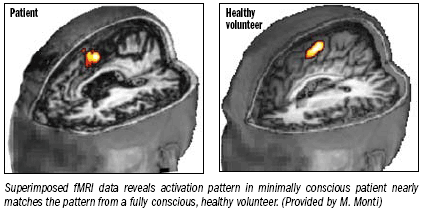fMRI lights up gap between consciousness and cognition
Using functional MRI, researchers in the U.K. have gained a better understanding of what goes on in the minds of patients who have sustained severe neurological damage.
Using functional MRI, researchers in the U.K. have gained a better understanding of what goes on in the minds of patients who have sustained severe neurological damage.
According to investigators, fMRI could yield evidence that patients might be fully aware even when the clinical assessment suggests they are comatose.
Clinicians typically infer whether patients with brain injury are conscious based on their behavior. However, recent studies indicate that 40% of patients who seem behaviorally unresponsive are, in fact, in a minimally conscious state and are erroneously diagnosed as being vegetative.
Such mistakes could have huge medical, ethical, and even legal consequences if they lead to termination of life-supporting therapies, said principal investigator Martin M. Monti, Ph.D., a research scientist for the Medical Research Council and Brain Sciences Unit, a University of Cambridge research partner institution.

Monti and colleagues enrolled 20 healthy volunteers and one minimally conscious patient diagnosed with anoxic brain injury in 2007. Subjects underwent imaging while instructed to listen to a sequence of words first and then count the number of times a key word was heard. All showed activation of neural areas governing target detection and working memory while performing the counting task. This suggests that even the minimally conscious patient could retain information over time and act upon it. It also shows that it is possible to tell if a patient is conscious or not, Monti said. The report was released online Oct. 8 in the journal Progress in Brain Research.
“This use of fMRI can help us better diagnose patients and diminish the misdiagnosis rate by allowing us to detect consciousness beyond what is apparent,” Monti told Diagnostic Imaging.
Such questions as how to know if patients who suffer severe brain injury are conscious, or how to tell whether they can hear, see, and understand, haunt neuroscientists. If patients can blink an eye in response to a command, physicians know they must be conscious. Trouble begins when perfectly conscious patients cannot move or produce any behavioral sign to convey this fact. The study makes a fundamental contribution in this regard, Monti said.
“The clinical application is immediate: If a patient is aware, but unable to produce a motor sign to communicate her state of awareness, it may be possible to gain this knowledge just by looking at her brain response.”
The Reading Room Podcast: Current Perspectives on the Updated Appropriate Use Criteria for Brain PET
March 18th 2025In a new podcast, Satoshi Minoshima, M.D., Ph.D., and James Williams, Ph.D., share their insights on the recently updated appropriate use criteria for amyloid PET and tau PET in patients with mild cognitive impairment.
New bpMRI Study Suggests AI Offers Comparable Results to Radiologists for PCa Detection
April 15th 2025Demonstrating no significant difference with radiologist detection of clinically significant prostate cancer (csPCa), a biparametric MRI-based AI model provided an 88.4 percent sensitivity rate in a recent study.